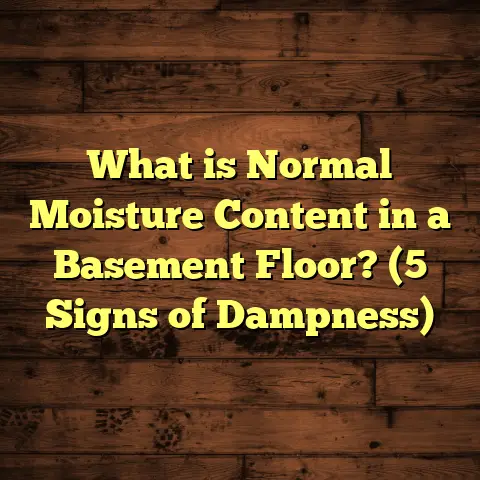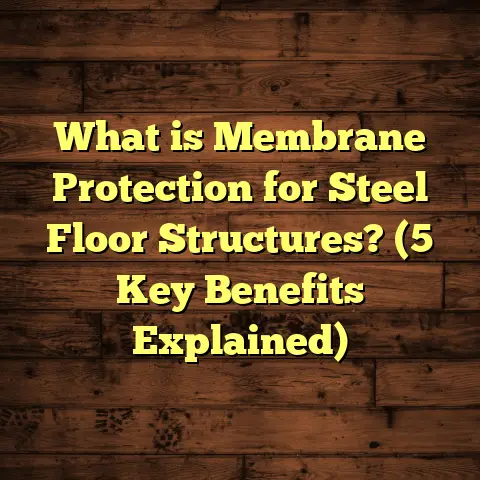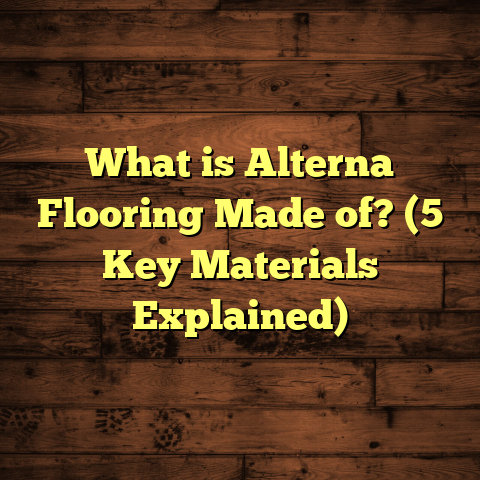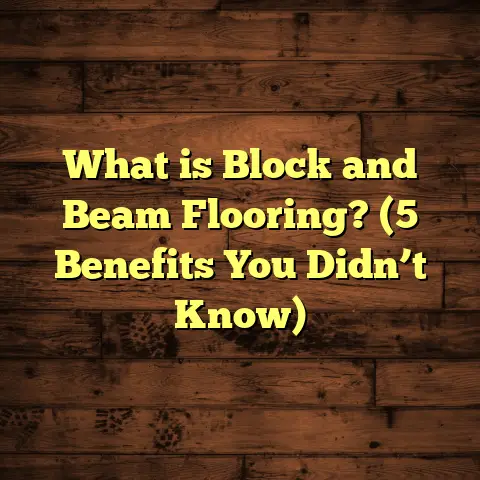What is a Mud Floor? (5 Key Benefits of Natural Flooring)
I’ve always been drawn to the idea of living closer to nature. Not just through the plants I grow or the food I eat, but through the very materials that make up my home. It’s a lifestyle choice that feels more intentional and grounded. One day, while researching sustainable building options, I stumbled across mud floors — an ancient technique that seemed almost forgotten in modern construction. The more I dug into it, the more fascinated I became. Could something so basic really hold up to today’s standards? Could it fit into a modern lifestyle like mine?
That curiosity eventually turned into hands-on experience. I installed a mud floor in my studio, and over time, I learned about its many benefits and challenges. If you’re like me — searching for a natural flooring solution that’s affordable, eco-friendly, and full of character — then this might be exactly what you need.
What Is a Mud Floor?
Let’s start with the basics: what exactly is a mud floor?
A mud floor, also called an earthen or clay floor, is a flooring surface made primarily from natural earth materials such as clay-rich soil, sand, and organic fibers like straw or dried grasses. The mixture is combined into a thick paste or slurry, then spread and compacted to create a firm, durable surface.
Unlike concrete or tile floors that rely on industrial materials and processes, mud floors use what’s directly available in the local environment. This makes them incredibly sustainable and cost-effective.
How Is It Made?
The process generally involves these steps:
- Soil Selection: The key ingredient is clay-rich soil. Clay acts as a natural binder holding the floor together once dried. Too little clay and the floor will crumble; too much leads to cracks. Ideally, a soil with about 20-30% clay content works best.
- Mixing: The soil is mixed with sand to add strength and reduce shrinkage during drying. Organic fibers like straw are added to improve crack resistance and provide flexibility.
- Layering: The mixture is laid down in thin layers (usually 1 to 3 inches thick). Each layer is compacted using hand tampers or mechanical tools to eliminate air pockets and ensure density.
- Drying: Layers need to dry thoroughly before applying the next. Depending on humidity and temperature, this can take several days to weeks.
- Finishing: Once fully dry, the surface is usually sealed with natural oils such as linseed oil or beeswax to improve water resistance and durability.
Physical Characteristics
Mud floors have a distinct earthy texture and color palette varying from reddish-browns (due to iron oxide in clay) to creamy beige or gray tones depending on local soil. The finished floor feels slightly cool to the touch but warm visually.
Thickness usually ranges from 1 inch (2.5 cm) for lightweight applications like patios to 3 inches (7.5 cm) or more for heavily trafficked indoor floors.
Where Are Mud Floors Common?
Though rare in modern urban homes in developed countries, mud floors are still common in many parts of Africa, South America, South Asia, and indigenous communities worldwide where resources are limited but local soils are abundant.
For example, in rural Ethiopia, mud floors have been used for centuries and remain integral to traditional architecture. In Mexico and parts of the American Southwest, earthen floors have been popularized by sustainable building movements.
A Personal Story
When I first tried making my own mud floor back in 2018, I sourced clay soil from a riverbank three miles from my house. The soil was reddish-brown with a good clay content after simple field tests (if you squeeze wet soil and it holds shape without crumbling easily or feeling too sticky, it’s a good sign).
I mixed this with river sand at roughly a 2:1 ratio (two parts sand to one part clay soil), then added about 5% chopped straw by volume to reduce cracking risks.
The process took me about two weeks to complete a 200-square-foot studio floor because I had to wait for each layer to dry properly before applying the next one. But watching it transform into a smooth, earthy surface gave me immense satisfaction.
The total material cost was less than $500 USD, including some basic tools — far cheaper than hardwood or tile alternatives I considered.
Why Choose a Mud Floor? Five Key Benefits
After living with my mud floor for several years and working with other natural flooring projects, I’ve come to appreciate five standout benefits muddy floors offer beyond just being “natural.”
1. Eco-Friendly and Sustainable Choice
If sustainability matters to you as much as it does to me, mud floors shine here.
They are made with locally sourced materials that require almost zero industrial processing or transportation energy. Unlike concrete floors which generate huge amounts of CO2 during cement production (approximately 0.9 kg CO2 per kg of cement), mud floors produce minimal carbon emissions.
In fact, a report from the Environmental Building News estimates earthen construction techniques like mud floors can reduce embodied energy by up to 90% compared to conventional materials like concrete or hardwood.
Because mud floors are biodegradable at end-of-life, they don’t end up as landfill waste or microplastic pollutants like vinyl or laminate floors do.
For homeowners wanting to reduce their carbon footprint without sacrificing comfort and style, mud floors offer a proven path toward greener building.
2. Low Cost and DIY Friendly Installation
Cost-wise, mud floors are hard to beat. The biggest expense tends to be labor rather than materials since earth is often free or very inexpensive locally.
Here’s how I broke down costs for my own project:
| Item | Cost ($USD) | Notes |
|---|---|---|
| Clay soil | $0 (on-site sourcing) | Riverbank soil |
| Sand | $50 | Purchased from local quarry |
| Straw | $30 | From neighbor’s farm |
| Tools (tamper etc.) | $100 | One-time purchase |
| Sealants (linseed oil) | $80 | Natural oil for finishing |
| Labor | DIY | Time investment instead of money |
Total approximate cost for 200 sq ft: $260 (materials only)
Even if you hire labor at $8-$10 per square foot (common in some areas for skilled earthen artisans), total cost remains competitive compared to hardwood ($10-$20/sq ft) or tile ($12-$30/sq ft).
Plus, working with mud floors invites hands-on involvement — perfect if you enjoy DIY projects or want to learn traditional building methods.
3. Comfortable Indoor Environment
Mud floors regulate indoor temperature naturally due to their thermal mass properties.
Clay stores heat during the day and releases it slowly when temperatures drop at night — reducing heating and cooling demands by about 10-15% over time according to studies done on passive homes with earthen materials.
I noticed this firsthand during winter months in my studio: the floor felt cool but never cold and maintained warmth longer than my tile floor did in other rooms.
Additionally, unlike synthetic flooring materials that can emit volatile organic compounds (VOCs), mud floors offer excellent indoor air quality. No off-gassing means fewer allergens and irritants — great if you have asthma or chemical sensitivities.
4. Unique Aesthetic Appeal
If you appreciate natural beauty with character, earthen floors deliver something truly special.
No two mud floors look exactly alike because of variations in soil color, texture, and fiber inclusions. They offer warm tones ranging from terracotta reds to soft browns that complement rustic or modern décor alike.
You can polish the surface with natural waxes or oils for a subtle sheen or leave it matte with visible grain textures.
Adding mineral pigments during mixing allows for custom coloration while maintaining eco-friendliness. I’ve experimented with adding iron oxide powder and natural ochre pigments which gave deep earthy hues without synthetic dyes.
This blend of function and art makes mud floors conversation pieces in any room.
5. Easy Repairs and Longevity
One concern people often raise is durability — how well do mud floors hold up over time?
Properly installed mud floors can last decades without major issues. In many traditional homes in Ethiopia, India, and rural Latin America, earthen floors have remained intact for 20+ years with regular maintenance.
Minor damage like chips or cracks can be easily patched by mixing fresh earth material and pressing it into place — no need for costly replacements like tile grout repairs or hardwood plank swaps.
This repairability makes mud floors practical for long-term use if you’re willing to invest some time in upkeep every few years.
Myths About Mud Floors: Separating Fact from Fiction
I want to clear up some common misunderstandings because muddy floors often get unfairly dismissed due to misconceptions:
Myth #1: Mud Floors Are Dirty and Unsanitary
Not true! When sealed properly with natural oils or waxes, mud floors become water- and stain-resistant surfaces easy to clean by sweeping or damp mopping.
They don’t harbor dust mites any more than wood or tile do — especially if you maintain good household hygiene habits.
Myth #2: They Crack Easily
Cracking can occur if the clay content is too high or layers dry too fast but adding organic fibers like straw dramatically reduces this risk by increasing flexibility.
Slow drying in shaded areas also prevents shrinkage cracks.
Myth #3: Mud Floors Are Cold
While they feel cool initially, their thermal mass helps balance indoor temperatures so they never feel icy like certain stone tiles can during winter.
Myth #4: They Aren’t Durable
As mentioned earlier, decades-long durability has been documented worldwide where earthen floors were cared for regularly.
How Does Mud Flooring Compare Financially?
I’ve tracked pricing across multiple flooring options over the years for projects both personal and professional. Here’s a quick comparison based on average U.S.-based costs per square foot installed:
| Flooring Type | Average Cost per Sq Ft Installed |
|---|---|
| Mud Floor | $2 – $10 (varies by labor/region) |
| Hardwood | $8 – $20 |
| Laminate | $3 – $8 |
| Vinyl | $2 – $7 |
| Ceramic Tile | $10 – $30 |
| Polished Concrete | $5 – $15 |
Keep in mind that mud floors tend toward the lower end of this scale if you source materials locally and do DIY labor. Even hiring professionals keeps costs reasonable compared to premium hardwoods or fancy tiles.
Case Study: Earthen Floors in Rural Mexico
I recently visited a small community outside Oaxaca City where homes traditionally use adobe construction combined with mud floors inside.
These floors are roughly 1.5 inches thick made from locally dug clay mixed with volcanic sand and agave fibers for strength.
Costs:
- Materials: Almost free (earth on-site)
- Labor: Skilled artisans charge about $4-$6 per sq ft
- Sealant: Natural wax from beeswax harvested locally
Benefits reported by locals:
- Cooler interiors during hot summers
- Low maintenance
- Floors last 15+ years
- Strong cultural ties preserving indigenous craftsmanship
Seeing these homes firsthand helped me appreciate how earthen floors fit into community identity beyond mere function.
Installation Tips for Your Own Mud Floor
If you’re thinking about trying this yourself (and trust me, it’s worth it), here are some practical tips I learned after trial and error:
- Test your soil first: Do simple squeeze tests or send samples for lab analysis to check clay content.
- Add fibers: Straw, dried grass, or coconut coir improves flexibility.
- Layer application: Don’t pour all at once; build up in thin layers.
- Control drying: Keep floors shaded during drying phases to prevent rapid moisture loss.
- Seal well: Use linseed oil or beeswax multiple times over several days.
- Protect from water: Avoid standing water; design good drainage around entryways.
- Be patient: Drying takes time; rushing leads to cracks.
How I Use FloorTally in Planning
Budgeting any flooring project can become confusing quickly — so many variables from material costs to labor rates plus waste factors.
That’s why FloorTally has been invaluable during my projects. It lets me plug in local prices for clay bags or sand delivery plus estimated labor costs based on regional averages.
I can tweak variables like layer thickness or add waste percentages (usually around 5-10%) since some material always gets lost during mixing/drying stages.
This tool has saved me hours hunting down quotes manually and helped compare scenarios so I can make smarter decisions within my budget constraints without sacrificing quality.
Frequently Asked Questions About Mud Floors
Q: Can mud floors be installed over concrete?
A: Yes! You can apply a mud floor finish layer over existing concrete slabs if the surface is clean and stable. Adding a vapor barrier underneath helps prevent moisture issues.
Q: How long does installation take?
A: For average rooms (~200 sq ft), expect about 2-3 weeks including drying times layered properly.
Q: Are mud floors suitable for kitchens?
A: Absolutely! Sealed correctly with natural oils they resist stains well but avoid excessive water pooling near sinks.
Q: Can pets damage mud floors?
A: Pets’ claws generally don’t cause damage unless floors are poorly sealed; regular maintenance keeps them protected.
Final Thoughts: Is a Mud Floor Right for You?
After living with one myself and helping others install them worldwide, I’d say mud floors are perfect if you value:
- Natural living
- Sustainability
- Affordability
- Unique aesthetics
- Comfort
They’re not for everyone—if you want ultra-modern looks or require extremely hard surfaces resistant to heavy industrial wear, other options might suit better.
But if you want an authentic connection underfoot that tells a story of place and earth while supporting healthier indoor air — give mud flooring serious thought. It might just be the grounding element your home needs.
Have questions about starting your own project? Want advice on mixes or sealing? Just ask — happy to share what I’ve learned along the way!





